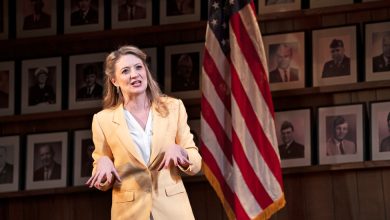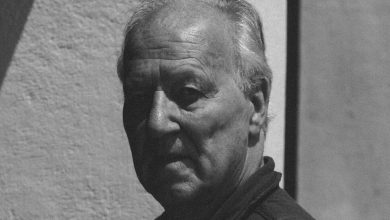A Conductor Comes Into His Own in the Opera Pit

SANTA FE, N.M. — “I was skeptical,” James Gaffigan said while waiting for huevos rancheros during a recent lunch here, where his run conducting a taut “Tristan und Isolde” at Santa Fe Opera ends on Tuesday.
Skepticism is not normally the emotion you hear expressed, or at least admitted, when interviewing conductors about their next big post. But Gaffigan, 43, is a congenial, quick-talking musician who is more honest and open than many of his peers. And the post in question — the one he was initially skeptical of — is at the Komische Oper Berlin, where he takes over as general music director next year.
Already doing a similar job at the Palau de les Arts Reina Sofia in Valencia, Spain, where his first season included “Wozzeck” and a Romeo Castellucci staging of Mozart’s Requiem, it seemed absurd, he said, to take on a second opera house — especially if it was to be the Komische.
Not exactly renowned for its conductors, with the small exception of Kirill Petrenko before he had really become Kirill Petrenko, the Komische has been a playground for directors since its founding by Walter Felsenstein in 1947. For the past decade, it has drawn acclaim under the virtuosic showmanship of Barrie Kosky, the outgoing intendant, who will continue to stage new productions at the house.
“It’s been the Barrie show, and that’s why my first instinct was to say no, or I’m not sure,” Gaffigan said. “I thought that whatever I did in the pit, how I developed the orchestra, would be overshadowed.”

Gaffigan rehearsing Wagner’s “Tristan und Isolde” in Santa Fe.Credit…Ramsay de Give for The New York Times
It’s a hesitation that Philip Bröking, formerly an in-house director who has been promoted to co-intendant alongside the Komische’s former managing director, Susanne Moser, understands, though he makes no excuses for the house’s specific character.
“Our choices, and I have to admit these were also my choices, of chief conductors haven’t been as successful as we expected,” Bröking said in an interview. “When Susanne and I got the job as intendants, we asked ourselves, ‘Where can we really improve?’ And we do know that the orchestra has a lot of potential.”
But Gaffigan marveled at the orchestra’s flexibility while first conducting them in a streamed concert of Webern, Gulda and Mozart in April 2021, and he agreed to take responsibility for two new productions, four concerts and a number of revivals in each of his four contracted seasons. Kosky, he said, convinced him that a double appointment — one at a newly built Spanish house that concentrates on the standard repertoire, the other among company that is as comfortable in Nono as in Handel, as committed to musicals as to the canon — would be an opportunity, not a burden.
“The more I thought about it, I realized they are the most versatile orchestra in town,” Gaffigan explained, adding that his first experience as an audience member at the Komische was a snowy, sold-out Tuesday night of Offenbach’s “Orphée aux Enfers” that showed him just how much its diverse audience trusts in what he called the “wackiness” of the house.
“We already have the public behind us because of what Barrie has done, and if we build the musical level even higher, it won’t just be a Regie theater,” he said. “I want people to come for the full package, and I think it’s possible.”
Even so, it’s a striking move. Gaffigan’s future had always seemed to lie on the symphony stage, not in the opera pit. Starting his career with junior posts at the Cleveland Orchestra and the San Francisco Symphony, he then served as the chief conductor of the Lucerne Symphony Orchestra for a decade, producing an eclectic list of recordings. He also became the principal guest of both the Netherlands Radio Philharmonic and the Trondheim Symphony orchestras, tenures that end this season.
Only a few years ago, Gaffigan was reputed to be on the shortlists of more than a few American ensembles searching for new music directors, and his enthusiasm, his keen interest in education and his flair for programming made him a strong candidate.
“He’s certainly somebody who American orchestras have their eye on,” said Gary Ginstling, the incoming president and chief executive of the New York Philharmonic, who leads the National Symphony Orchestra in Washington, where Gaffigan conducts Bernstein’s “Mass” to celebrate the Kennedy Center’s 50th anniversary in September. “I think he has a lot of options, and will continue to.”
But although Gaffigan has been in the running for a number of American posts, he has decided to step out of the fray for the time being.
“I would need it to be the right city in America, with the right vision,” he said. “I don’t want to do the complete Brahms symphonies. Who cares? It needs to be a forward-thinking institution. I don’t want to be repeating the same stuff over and over again, and right now, I don’t see it.”
Tired of the old routines, of programs announced far in advance that run through an overture, a concerto and a symphony, Gaffigan is also bothered by orchestras that refuse to reckon with their whiteness.
“I hate that something that I love so much is defined as something elitist,” said Gaffigan, a native Staten Islander and public school graduate. “It upsets me that I’m from a country that has so many different types of people, yet when I look into the audience, I only see one type. That hurts me, as an American. I don’t just say it to sound politically correct; it’s something I believe.”
Gaffigan may see no good fit for him at home, or none that is open to him, but Bröking said that the conductor’s interest in music not traditionally explored by American ensembles made him a natural choice for the Komische Oper when it was searching for someone to replace its current music director, Ainars Rubikis.
“The first phone call with James was in April 2020,” Bröking recalled. “What was very special about this telephone call was that he did not ask: ‘What can my repertoire be? Is it Verdi, is it Puccini, is it Wagner?’ These are the questions you usually get, because as a general music director, you would like to present yourself in the core repertoire, especially in Berlin. He was much more interested in the special situation of the Komische Oper, between the Staatsoper and the Deutsche Oper.”
What also appealed to the Komische is that Gaffigan, ambitious but far from egoistical, actually seems to practice what so many of his colleagues preach about a consciously collaborative style.
“In Berlin, we have some experience with old, master conductors,” Bröking said wryly. “They do fantastic work, of course they do, but half of our orchestra are women, there are many young instrumentalists, and they don’t want to be treated as in former times. They want to communicate, they want to build something together, they want to be a team. This is what James is able to do well.”
Gaffigan’s “Tristan” in Santa Fe sounded as though it had been carefully prepared, as indeed it had, with him listening to every historical recording he could find and even getting “crazy into poetics,” as he put it. But it was also evident that he was far less concerned with prosecuting his own interpretation of the drama, than in sustaining the staging that was in front of him.
“He’s in service to the whole,” said Zack Winokur, who co-directed the “Tristan” with Lisenka Heijboer Castañón and is the artistic director of the avowedly egalitarian American Modern Opera Company. “It’s an unusual thing with conductors, that it’s not Machiavellian, that it didn’t feel manipulative,” Winokur said of the experience. “It felt actually supportive.”
Tamara Wilson, the soprano who made a breakthrough debut as Isolde, agreed that Gaffigan’s style is unusual in the opera world, and happily so.
“The first thing that he asked,” Wilson recalled of an early meeting on Zoom, “was, ‘How do you want to run rehearsals?’ For a singer, that’s unheard-of. That is never, ever how it goes. I had an immediate sense of relief, because I knew that this was going to be a collaboration, versus me being yelled at.”
She added: “Even listening to the Santa Fe orchestra the first time, you could tell it wasn’t about just doing it and getting it right, making it correct — it was about making it special. And that’s what he does. He makes things special.”




